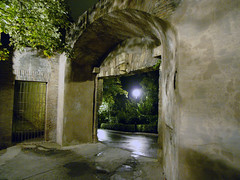
The Black Scroll. A story of black magic and power in Roman North Africa
June 24 was the day I “finished” The Black Scroll. I put ‘finished’ in quotation marks because I’m starting the edit.
But the story is told. It is out of my imagination and now exists in the concrete world of words down on paper. Paper in this case is a digital format, but you get what I mean.
Whew! What a mind-bending experience. I had to pinch myself this morning. I did it! I wrote the trilogy that I’ve envisioned since 2010. The stories of Isis, Athena and Elektra.
There’s been months of hiatus here and there. The Arab Spring starting with Egypt and continuing through Libya. The remix of Isis to Isis Erotica and Isis BeachRead. Family trials and tribulations of late. You know – life getting in the way.
More intricate and involved with a much wider scope than The Red Mirror and The Emerald Tablet, The Black Scroll took a tremendous expenditure of psychic energy to tell. The Romans weren’t nice people. I was juggling memories of four lifetimes with recurring characters. I wanted to wrap everything up – cross all the t’s, dot all the i’s, tie up loose ends.
It’s a longer book, which may or may not remain so after the editing. But I have a feeling it will. The story is complex and action-filled. At least I hope so. It is in my mind, anyway. A fellow author said satisfyingly, “The monumental third volume.” I like the sound of that.
I’ve promised a couple of people to be first readers, and I haven’t forgotten that pledge. I’ll do an edit and then print a few draft copies for distribution.
In the meantime, I’m gonna savor my thrill. There’s not many moments in a lifetime like this.
June 26, 2013 at 4:55 pm
All of us have seen beautiful works of art from ancient Egypt. Here I’d like to share some photos I’ve taken that give you a feeling for the daily life of my Isis of The Red Mirror. These are actual artifacts, thousands of years old.
If you’re like me, you love to imagine the hands that poured jasmine oil from glass flasks – or shaved heads and mounds with copper blades. Each object has a story – tales of love and disappointment, tragedy and triumph. And each object has a history that begins with the man who wrought it into being and those who used or wore it, then continues through the lives of all who have held the object in their own hands over the centuries – and finally to those who gaze upon it in wonder today.

Isis wears a beaded dress to the Khent-min market. This version was worn by a 12-year old concubine of a Pharaoh. Petrie Museum

Detail of a beaded dress British Museum

The curled hair and beard of another Persian General. British Museum

A faience beaded necklace that Isis could have worn. British Museum

Egyptian game Isis might have played on her barge to pass the time. British Museum

Sit-Hathor could have worn this wig. Cairo Museum

The Vulture with outstretched wings painted on temple door lintels. Valley of the Kings tomb

Glass flasks like these held the oils that Maia poured into Isis’ bath. Petrie Museum

Sistrum with Head of Hathor. British Museum

Copper blades like these shaved Isis’ head. Petrie Museum

Sedge rope to lash Isis’ barge to the stone quay. British Museum

Antinous drew one of these swords when confronting Hetmus. Petrie Museum

From Antinous to Isidora. Greek style jewelry. All gold and no stones. British Museum

Isis would never have worn the plain sandals of a common Egyptian. Petrie Museum
June 4, 2013 at 8:07 pm




























The Black Scroll has entered edit phase
The Black Scroll. A story of black magic and power in Roman North Africa
June 24 was the day I “finished” The Black Scroll. I put ‘finished’ in quotation marks because I’m starting the edit.
But the story is told. It is out of my imagination and now exists in the concrete world of words down on paper. Paper in this case is a digital format, but you get what I mean.
Whew! What a mind-bending experience. I had to pinch myself this morning. I did it! I wrote the trilogy that I’ve envisioned since 2010. The stories of Isis, Athena and Elektra.
There’s been months of hiatus here and there. The Arab Spring starting with Egypt and continuing through Libya. The remix of Isis to Isis Erotica and Isis BeachRead. Family trials and tribulations of late. You know – life getting in the way.
More intricate and involved with a much wider scope than The Red Mirror and The Emerald Tablet, The Black Scroll took a tremendous expenditure of psychic energy to tell. The Romans weren’t nice people. I was juggling memories of four lifetimes with recurring characters. I wanted to wrap everything up – cross all the t’s, dot all the i’s, tie up loose ends.
It’s a longer book, which may or may not remain so after the editing. But I have a feeling it will. The story is complex and action-filled. At least I hope so. It is in my mind, anyway. A fellow author said satisfyingly, “The monumental third volume.” I like the sound of that.
I’ve promised a couple of people to be first readers, and I haven’t forgotten that pledge. I’ll do an edit and then print a few draft copies for distribution.
In the meantime, I’m gonna savor my thrill. There’s not many moments in a lifetime like this.
Share this:
June 26, 2013 at 4:55 pm 1 comment